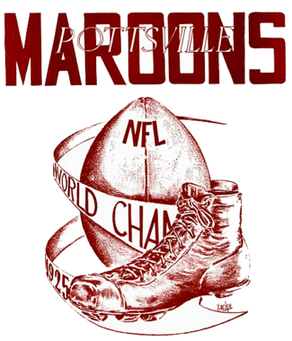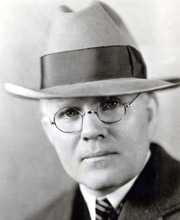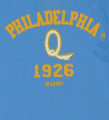
The Frankford Yellow Jackets were a professional American football team, part of the National Football League from 1924 to 1931, although its origin dates back to as early as 1899 with the Frankford Athletic Association. The Yellow Jackets won the NFL championship in 1926. The team played its home games from 1923 in Frankford Stadium in Frankford, a section in the northeastern part of Philadelphia, noted for the Market–Frankford Line that terminates there.

The Providence Steam Rollers were a professional American football team based in Providence, Rhode Island in the National Football League (NFL) from 1925 to 1931. Providence was the first New England team to win an NFL championship. The Steam Roller won the league's championship in 1928, which is the latest NFL championship win by a defunct team to date. Most of their home games were played at the Cycledrome, a 10,000-seat stadium that was built as a velodrome for bicycle races.

The Pottsville Maroons were an American football team based in Pottsville, Pennsylvania, in the northeastern part of the state. Founded in 1920, they played in the National Football League (NFL) from 1925 to 1928. In 1929 they relocated to Boston, where they played one season as the Boston Bulldogs.

The Orange Tornadoes and Newark Tornadoes were two manifestations of a long-lived professional American football franchise that existed in some form from 1887 to 1941 and from 1958 to 1970, having played in the American Amateur Football Union from 1888 to 1895, the National Football League from 1929 to 1930, the American Association from 1936 to 1941, the Atlantic Coast Football League from 1963 to 1964 and 1970, and the Continental Football League from 1965 to 1969. The team was based for most of its history in Orange, New Jersey, with many of its later years in Newark. Its last five seasons of existence were as the Orlando Panthers, when the team was based in Orlando, Florida. The NFL franchise was sold back to the league in October 1930. The team had four head coaches in its two years in the NFL – Jack Depler in Orange, and Jack Fish, Al McGall and Andy Salata in Newark.
The Milwaukee Badgers were a professional American football team, based in Milwaukee, Wisconsin, that played in the National Football League from 1922 to 1926. The team played its home games at Athletic Park, later known as Borchert Field, on Milwaukee's north side. The team was notable for having many African-American players for the time.

Joseph Francis Carr was an American sports executive in football, baseball, and basketball. He is best known as the president of the National Football League from 1921 until 1939. He was also one of the founders and president of the American Basketball League (ABL) from 1925 to 1927. He was also the promotional director for Minor League Baseball's governing body from 1933 to 1939, leading an expansion of the minor leagues from 12 to 40 leagues operating in 279 cities with 4,200 players and attendance totaling 15,500,000.
The 1924 NFL season was the fifth regular season of the National Football League. The league had 18 teams play during the season, including the new clubs Frankford Yellow Jackets, Kansas City Blues, and Kenosha Maroons. The Louisville Brecks, Oorang Indians, St. Louis All Stars and Toledo Maroons folded.
The 1925 NFL season was the sixth regular season of the National Football League. Five new teams entered the league: New York Giants, Detroit Panthers, Pottsville Maroons, Providence Steam Roller, and a new Canton Bulldogs team. The Kenosha Maroons folded, with the Racine Legion and Minneapolis Marines mothballing.
The 1928 NFL season was the ninth regular season of the National Football League. The league dropped to 10 teams as the Cleveland Bulldogs and the Duluth Eskimos both folded before the season, while the Rochester Jeffersons, after missing two seasons of play, also folded, and the Buffalo Bisons also had a year out from the league. The Detroit Wolverines were added as an expansion team.

The Philadelphia Quakers were a professional American football team that competed in the first American Football League in 1926 and won the league's only championship.
Francis Dale "Hap" Moran was an American football halfback who played in the National Football League (NFL) for the Frankford Yellow Jackets, the Chicago Cardinals, the Pottsville Maroons and the New York Giants. He played college football for Carnegie Tech and Grinnell.
The first American Football League (AFL), sometimes called AFL I, AFLG, or the Grange League, was a professional American football league that operated in 1926. It was the first major competitor to the National Football League (NFL). Founded by Charles "C.C." Pyle, (1882–1939), and General Charles X. Zimmerman, (1865–1926), as vice president and starring Hall of Fame halfback Harold Edward "Red" Grange, (1903–1991), the short-lived league with nine teams competed against the more established – then six-year-old – NFL, both for players and for fans. While Pyle's and Grange's New York Yankees team and the already established Philadelphia Quakers became reliable draws, the lack of star power and the uncertain financial conditions of the other seven teams led to the league's dissolution after one season.
The 1925 New York Giants season was the franchise's inaugural season in the National Football League. The team finished with a record of 8–4 against league opponents.
The 1925 Chicago Cardinals season resulted in the Cardinals winning their first NFL championship. The 1925 championship is contested and never awarded by the NFL after the Pottsville Maroons were suspended.
The 1925 Frankford Yellow Jackets season was their second in the National Football League. The team improved on their previous output of 11–2–1, winning thirteen league games to finish the season in sixth place. The team's overall record, against league and non-league opponents in 1925 was 15–7. They set the unofficial record for most games played in a season during the years before the league went to a fixed-length schedule: they played 20 NFL games Even counting playoff games, no NFL team has since played more than 20 games in a season.
The 1925 Milwaukee Badgers season was their fourth in the National Football League. The team failed to improve on their previous league record of 5–8, losing all their games. They tied for sixteenth place in the league.
The 1925 Rochester Jeffersons season was their sixth and final season in the National Football League. The team improved on their previous record against league opponents of 0–7, losing only six games and logging a tie. They tied for sixteenth in the league.
Christopher O'Brien was a Chicago, Illinois house painter and plumber who became a pro football franchise owner. He is mostly known as the owner of the Chicago Cardinals, and has been called the "Father of Professional Football in Chicago". O'Brien was also a co-founder of the American Professional Football Association by representing the Cardinals at the September 17, 1920, league meeting at Ralph Hay's Hupmobile dealership in Canton, Ohio.
The 1925 Chicago Cardinals–Milwaukee Badgers scandal was a scandal centered on a 1925 game between the Chicago Cardinals and the Milwaukee Badgers of the National Football League. The scandal involved a Chicago player, Art Folz, hiring a group of high school football players to play for the Milwaukee Badgers against the Cardinals. This would ensure an inferior opponent for Chicago. The game was used to help prop up their win–loss percentage and as a chance of wresting the 1925 Championship away from the first place Pottsville Maroons.

The professional American football team now known as the Arizona Cardinals previously played in Chicago, Illinois, as the Chicago Cardinals from 1898 to 1959 before relocating to St. Louis, Missouri, for the 1960 through 1987 seasons.







